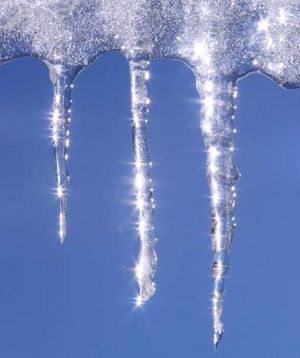Freezing facts for kids
Freezing is a cool process where a liquid changes into a solid. Imagine water turning into ice! This happens when an object loses heat. When heat is lost, the tiny molecules inside the liquid slow down. As they slow down, they start to stick together more tightly, forming strong bonds.
Freezing is the opposite of melting, which is when a solid turns back into a liquid. For water, freezing happens at 0 degrees Celsius (32 degrees Fahrenheit). But other liquids can freeze at much higher or lower temperatures. Most liquids can freeze, and this process is very important in many areas, like making metal objects.
For most things, the temperature at which they melt is the same as the temperature at which they freeze. However, some special substances are different. For example, a substance called agar melts at 85°C (185°F) but then turns back into a solid between 32°C and 40°C (90°F to 104°F).
Contents
How Liquids Freeze: Crystallization
Many liquids freeze by a process called crystallization. This means they form a crystalline solid from their liquid state. Think of how snowflakes form – they are tiny ice crystals!
Crystallization involves two main steps:
- Nucleation: This is when the molecules in the liquid start to gather together. They begin to arrange themselves in a very neat and repeating pattern, which is the start of a crystal structure.
- Crystal growth: After the tiny crystal "seeds" (nuclei) form, they start to grow bigger. More molecules join the pattern, making the crystals larger.
Heat Release During Freezing
Freezing almost always releases heat. This is called an exothermic process. It might seem strange because the material's temperature doesn't usually go up when it freezes. But heat must be continuously removed from the liquid for it to keep freezing. If you stop removing heat, the freezing process will stop.
The energy released during freezing is known as "latent heat." It's the exact same amount of energy that is needed to melt the same amount of the solid.
There are a few rare exceptions, like very cold helium. For example, Helium-3 and Helium-4 at extremely low temperatures actually need heat to be added to them to make them freeze!
When Liquids Don't Form Crystals: Vitrification
Some materials, like glass or glycerol, can harden without forming crystals. These are called amorphous solids. They don't have a specific freezing point like water does. Instead, they slowly become thicker and more solid over a range of temperatures. There isn't a sudden change from liquid to solid.
Freezing and Living Things
Many living things can survive for a long time in temperatures below the freezing point of water. Most plants, for example, can handle temperatures down to about -4°C to -12°C (25°F to 10°F).
Some bacteria, like Pseudomonas syringae, can even make special proteins that help ice form on the surface of plants at around -2°C (28°F). This freezing can hurt the plant, making nutrients available for the bacteria.
Human gametes (reproductive cells) and early embryos can be frozen and stored for up to 10 years. This process is called cryopreservation. There are also experimental attempts to freeze human beings for future revival, which is known as cryonics.
Freezing for Food Preservation
Freezing is a very common way to keep food fresh. It slows down how quickly food spoils and stops tiny micro-organisms from growing. People have been using freezing to preserve food for a very long time, even before mechanical refrigerators were invented.
When food is frozen, its flavors, smell, and nutritional value usually stay the same. Freezing became popular for food preservation after mechanical refrigeration was introduced. Many people think freezing is a better way to preserve food than canning or drying it.
Related pages
See also
 In Spanish: Solidificación para niños
In Spanish: Solidificación para niños


